See Your Way Clear: Organize With Transparent Sticky Notes

Longtime Paper Doll readers know that I’ve had a complex relationship with sticky notes. On the one hand, in the very first month of this blog, all the way back in 2007, I railed against writing things on random pieces of loose paper in Stay Far From Floozies: Avoiding the Loose Paper Trap.
On the other hand, over the years I’ve broadened my approach. It’s not the sticky notes, per se, personified by 3M’s Post-it® Notes, that left me chagrined, but the act of writing things you want to remember on any visible piece of paper, without rhyme, reason, or organizational process. To that end, I’ve shared a wide variety of pro-sticky note posts, including:
- Organizing With Post-it® Notes: Revenge of the Floozies — Three years after coining the expression “floozies” for loose paper and casting aspersions on sticky notes, I praised the ways you could effectively use sticky notes to keep yourself organized in the office, in dorm rooms and when studying, financially, and when planning projects.
- Sticky to the Extreme: Organizing Information in Extreme Situations with Post-it® Extreme Notes — These super-powered stickies handle the extreme conditions of heat, cold, humidity while preserving powerful delivery of the message.
- Paper Doll Adds a Pop of Color with Bright & Sunny Office Supplies offered up a colorful review of the Post-it’s ten different themed families of note hues for brightening your work day.
- Paper Doll Shares 3 Quirky & Cool New Office Supplies looked at the niftiness of lined sticky notes (and devices for neatly making bullets and lines on them)
- Emerson, Angelou, Ted Lasso, Tashlich & Zen Monks: Letting Go for a Fresh Start was ostensibly about new perspectives and giving yourself a new beginning, but it also introduced 3M’s super-nifty Super Sticky Big Notes, 11″ x 11″ and 15″ x 15″ sticky notes.
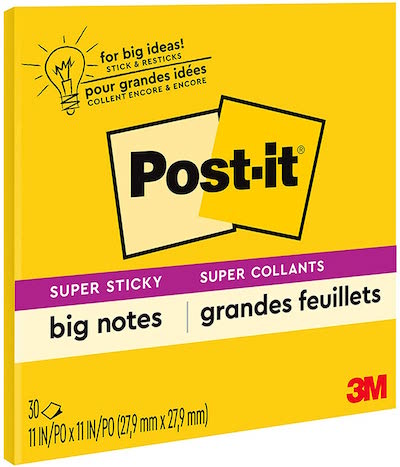
- Paper Doll Helps You Find Your Ideal Analog Habit Tracker — They may look like they’re just tiny scraps of paper, but both traditional sticky notes and specialty items (mini-lists, planners, and habit-trackers) in the Noted by Post-it® line offer cheery solutions for keeping your life organized. We looked at an expanded view of some of the Noted products in In Search of Lost Time: Productivity, Proust, and the Culture of Availability.
So, let me be perfectly clear: stickies have have a place in organizing — as long as they’re used intentionally, mindfully, and not randomly.
With all this in mind, today’s Paper Doll post explores another intriguing sticky note option reminiscent of the novelty we discussed back in 2012 when I looked a different transparent office supply solution, in Paper Doll Rolls the Highlight Reel: Removable Highlighter Tape.
BENEFITS AND USES OF TRANSPARENT STICKY NOTES
When it comes to organizing thoughts and information, I want the benefits of transparent sticky notes to crystal clear.
In case you’ve never seen a transparent sticky note, think of it as combining the functions of tracing paper and sticky notes.
Transparent sticky notes — which, to be fair, I generally more translucent or slightly “frosted” than entirely transparent — offer several benefits that distinguish them from traditional opaque ones, especially for organizing and annotating. Additionally, the notes (though not the writing) are waterproof and are generally more durable than traditional sticky notes.
Having trouble envisioning how they work? Take a peek:
Academic Uses
Transparent sticky notes are ideal for students at all levels, but particularly in high school and college, especially when studying texts where annotations are helpful or even necessary but the page or document must not be permanently altered.
Transparent sticky notes allow students to scribble questions, ideas, connections, and thoughts directly over content. The notes can be applied, easily removed or repositioned, and (if carefully stored) applied again later.
- Overlay Text or Drawings Without Obscuring What’s Beneath
Transparent sticky notes allow you to place and affix notes directly over text or diagrams without covering the printed content.
This is particularly useful for annotating books and textbooks, source documents, or presentations where you want to preserve visibility of the original material.
Science textbooks often include complex illustrations of plants, processes, or anatomical design. Students can learn a few elements at a time, add explanatory text to the overlaid sticky notes, remove the note to test themselves, and create new ones for different elements.
- Highlight and Emphasize Information
By placing a transparent sticky note over a portion of text or an image, you can use a highlighter or writing implement to highlight, annotate, or draw attention to specific details without making permanent marks on the original material.
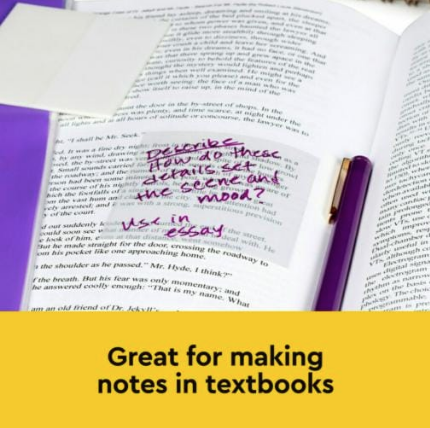
You can use a highlighter directly on a clear transparent sticky note; tinted translucent notes let you both color code concepts or categories and serve the same accenting purpose as a traditional highlighter.
Teachers can write comments pointing to specific areas of a student’s work while not damaging the masterwork, and tutors can add explanatory guidance to notes and then remove them when coaching students to remember what was on them.
Students using printed textbooks can highlight or annotate content, remove and re-affix the notes for studying and self-testing, and then re-sell the practically pristine textbook to the college bookstore after the final exam! (Yes, I know college students primarily use digital textbooks now, but they still read many novels and auxiliary books and use workbooks in traditional formats.)
- Copy content to paste into notes
Remember how I said that transparent sticky notes work like a combination of a traditional sticky note and tracing paper? Trace directly from your text book and then affix what you’ve traced into your handwritten notes.
The hand-brain connection means that students will remember the material much better from the experience of hand-tracing than they might if they only photocopied an illustration or chart.
Organizational Uses
This is an organizing blog, after all, so we should look at the organizing advantages.
- Layer for Enhanced Organization
You can layer transparent sticky notes on top of one another or over documents without losing sight of the information underneath. This can be useful in complex planning, when you want to group ideas visually without obscuring the main content.
Again, students can use layering for studying illustrations or maps, adding their notes and layering different types of content on top of the original material, with layer upon layer adding more nuance and detailed information. (I’m reminded of my 9th grade Social Studies class where, when faced with a blank mimeographed map of Africa, we had to learn (and later fill in on subsequent weeks), the country names, then the capitals, then the colonial influences, and the top exported product. I could have really used transparent notes, but regular Post-it® Notes hadn’t made it to our school supplies yet!)
- Reorganize Ideas Easily
One of the great benefits of traditional sticky notes is that you can move them around, but again, transparent/translucent sticky notes augment that benefit. They allow for more flexible, real-time organization of thoughts, whether they’re used on a document or handout, the page of a textbook or workbook, or even on a large-format item like a map, poster, or whiteboard.
Improve Every Stage of a Project
When you work (or study) in a creative field, your work often has many iterations. Having an overlay for things that aren’t (yet) perfect gives you flexibility to be creative without fear of losing a creative draft or burst of genius.
- Clear the Way for Creative Work
Transparent sticky notes can help for artists, designers, and creators who need to annotate their thoughts without hiding underlying sketches or design elements. Create temporary markups and adjustments without altering the original work.
Musicians might create an overlay with the conductor’s suggestions written on an angle, above or below the measures, bars, and notes.
- Collaborate and Brainstorm
In collaborative environments — picture a Mad Men-style creative team or a garage band figuring out how different instruments and vocals might come together — transparent sticky notes enable participants to add thoughts or ideas on top of shared content, whether on a design, blueprint, or lyric sheet.
The ability to make changes without altering the original fosters more flexible brainstorming sessions without fear of losing track of the original document or a sequence or flow of ideas.
Who else might use transparent sticky notes?
The unique properties make transparent sticky notes a versatile option in various context. In addition to traditional students and teachers in an academic setting, who else might use these notes?
- Authors — Most authors now edit galley copies of their books digitally, directly in PDF files. However, editing that way isn’t always comfortable. Writers might choose to make notes (on clean copies of their galleys or even printed drafts) and then highlight changes on transparent stickies.
- Memoirists — Reading your own handwritten journals to help document the history of your thoughts and actions? You probably don’t want your 2024 handwritten notes directly on the pages of your circa-1981 Snoopy diary, but overlaying transparent sticky notes helps the you in the present engage with the you of the past.
- Researchers — When faced with a variety of primary sources that can’t be doodled upon (or when you don’t have access to a copy machine but would prefer to handwrite your notes layered over a document), a transparent note can help you make a deeper connection between your thoughts and the original work than taking notes on a computer or pad of paper.
- Book reviewers — Whether you review books professionally or just for Amazon or Goodreads, it’s helpful to have your contemporaneous thoughts while reading and your highlighted quotes at the ready. If you find marking up books to be almost sacrilegious, transparent stickies are a great option.
- Cooks — Some people take recipes in cookbooks as gospel; others like to “doctor” things up. If you were experimenting as you went, you might not want each changed variable to be written onto the original recipe, but you’d still want to track the changes you made until (or even after) you achieved delicious perfection. TheKitchn blog post This Mind-Blowing BookTok Trend Will Change the Way You Use Your Cookbooks is a bit hyperbolic but does show the use case in action.
- Attorneys — Boilerplate contracts are in computers, and paralegals make the revisions digitally as instructed. But most lawyers can be seen reviewing photocopies of contracts and mocking them up with revisions. Transparent sticky notes would let them see the original contract language, highlight relevant passages, and make revisions; similarly, they might use transparent notes to help them accent points in transcribed depositions and testimony they want to refer to in court.
- Spiritual adherents — Whether you participate in some kind of formal Bible study or just like reading holy texts from any of a variety of comparative religions, you probably don’t want to scribble your thoughts in the (or any) “Good Book.” Use transparent sticky notes to highlight and annotate questions, feelings, or motivational elements.
- Crafters — Whether you’re trying to map colors for a needlepoint project or adjust the measurements on a pattern, writing directly on the instructions or designs can get messy, especially if you need to revise your notes. A transparent overlay lets you adjust without the mess.
How might you use a transparent or translucent sticky note?
CHALLENGES PRESENTED BY TRANSPARENT STICKY NOTES
While transparent sticky notes offer many benefits, they do have some downsides to consider.
Potential for Residue
Some brands of transparent sticky notes might leave a slight residue, especially if left on delicate surfaces for an extended period. (Bibles and textbooks from before the1950s tend to have pages that are as thin as tissue paper.)
Obviously, this varies depending on the quality of the adhesive used, and higher-end (and honestly, brand-name) versions will typically avoid this problem. If the book or document you’re using is delicate, test it on a back page, like in the glossary or index.
Adhesive Strength
Transparent sticky notes may not be adhere as strongly as traditional opaque sticky notes, particularly on rougher surfaces. Unlike the recycled paper of traditional sticky notes, the slightly slick material used to make transparent sticky notes makes the notes more durable but the adhesive may be less durable. This means they might peel off more easily, especially on surfaces that aren’t perfectly smooth or when the notes are repositioned (or applied, removed, and re-applied) multiple times. Again, test them.
Writing Challenges
Depending on the material, certain pens and markers may not write as well on transparent sticky notes. This can limit their functionality (compared to traditional paper-based sticky notes) if you (like Paper Doll) prefer one specific type of pen. Again, brand-name versions are likely to allow a greater variety of pen use; Post-it® shows multiple examples of workable writing implements.

Less Absorbent Surface
Unlike paper sticky notes, which easily absorb ink, transparent sticky notes are usually made from plasticky or filmy material, like stiff, glossy tracing paper. This can cause ink to smear or take longer to dry.
Most of the TikTok videos I found on the topic are in agreement that mechanical pencils, ball-point pens, and markers work best, and that water-based highlighters and pens are the least effective. If you use markers or gel pens, especially if you also intend to highlight what you’ve written, be sure to let the ink dry thoroughly before touching or highlighting.
Limited Color Options
While some transparent sticky notes come in pastels and neons, they usually lack the range of vibrant colors available with opaque sticky notes, especially the myriad Post-it® colors. This can limit your ability to color-code effectively when organizing ideas. You can easily find colorful options, but perhaps not your preferred color schemes.
Glare and Reflection
Due to their transparent nature, this kind of sticky note may glare under certain lighting conditions, making them more difficult to read or see clearly in brighter environments or on glossy surfaces.
Cost
Transparent sticky notes, whether brand name Post-it® versions or generic, tend to be slightly more expensive than their opaque counterparts, so if you’re on a budget or need a lot of them, the cost could be a drawback.
If you’re using these sticky notes for creative, academic, or professional purposes where clear visibility is key, these downsides may be manageable. However, for heavy-duty or everyday use, traditional sticky notes are usually going to be more practical.
VARIETIES OF TRANSPARENT STICKY NOTES
According to the website, Post-it® Transparent Notes come in 7 varieties, all with 36 notes per pad (though I was able to find an additional 10-pack of the clear version at Staples.com for a whopping $26.46)!
- original transparent (clear) pad ($7.29 at Staples.com or $5.35 at OfficeSupply.com)
- a two-pack with one original clear pad and one blue pad
- a three-pack assortment (pink, orange, and green) pads ($12.59 at Quill)
- a five-pack assortment (purple, orange, pink, blue, and green)
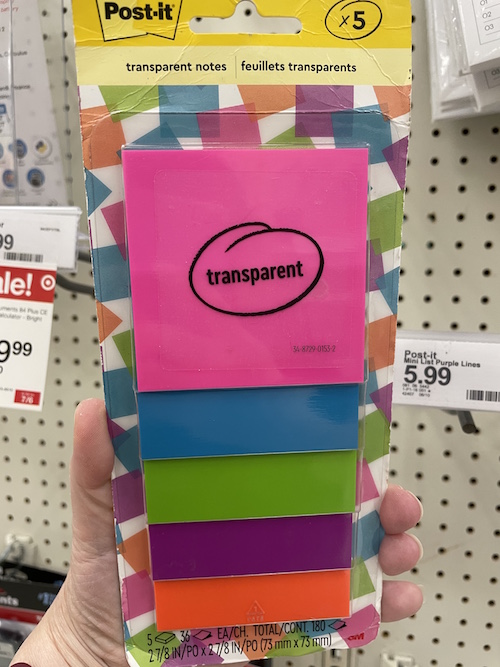
- an eight-pack with four clear pads and one pad each of orange, pink, blue, and green
- an eight-pack with two pads each in blue, pink, green, and orange ($14.99 at Amazon)


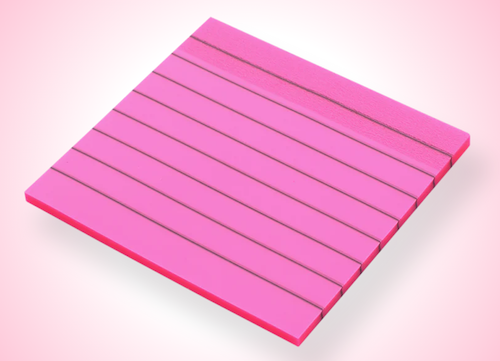 (I’ve yet to figure out how TikTok Shop advertisers and companies like Temu and Shein can afford to price their products so low. Caveat emptor.)
(I’ve yet to figure out how TikTok Shop advertisers and companies like Temu and Shein can afford to price their products so low. Caveat emptor.)

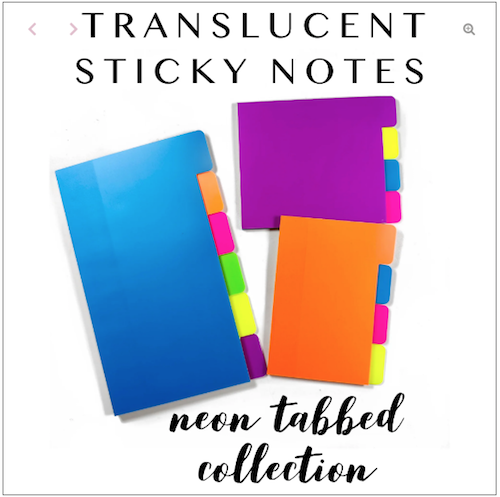





I’m a sucker for a new type of sticky note! I vow to think of an actual use before purchasing, though, and to check back here for an affiliate link if I do.
I am, too! Several years ago, there were versions of sticky note “pockets” — adhesive backing, open slot at the top. I had relatively few use cases, but I wrote about them anyway because they were so nifty. Lined, colored, super-sticky, ready for extreme heat, transparent/translucent. I don’t know what’s next, but I already want it!
I didn’t mention it in the post, but I’m intending to use mine in my Italian workbook. I usually use Duolingo, but I got myself a text with workbook pages. I’d rather keep the workbook clean and write the answers superimposed. Thanks for thinking about popping back here if you get some!
Well, this is a new one on me. Thanks for doing all the research so I can sound smart about these. 🙂
I wish the adhesive were better, because I think I would be most inclined to use them in more “weathery” areas, like garages and attics, because the paper itself is stickier and probably holds up better. I typically use the notes with the adhesive across the whole back, but over time even they can get damaged.
I see the potential for students. They are perfect for marking things up in school copies of books and then being able to easily remove them before returning the book to the school. At the same time, I’ve seen a true shift away from books, especially at the higher levels of education. My girls graduate school materials were almost all online (one B school, one an SLP). It’s too bad because I think paper is still preferable for studying.
Heh, research is my jam, Seana, so I’m glad to help. The adhesive isn’t bad if you go with Post-it, and while I haven’t tried Redi-Tag, it’s a Pendaflex brand, so I suspect it’s at least as sticky (and without residue) as a standard note. But I get being dubious about the staying power of generic and unknown brands.
You’re right! Studying from textbooks isn’t just personally preferable; research shows that different areas of the brain are used when operating digitally vs. with analog resources. Taking handwritten notes and adding hand-traced drawings, and learning by drawing/tracing constellations, anatomical systems, parts of flowers, chemical bonds, etc. really improves the learning experience. As I noted in the post, while textbooks have gone digital, analog auxiliary materials like novels, lab books, and workbooks really do have staying power!
Thanks for reading!
I’ve never seen transparent sticky notes. Where have I been? Oh, I wish these had been around when I was in school. These would be great for note-taking.
Aren’t they neat? I love finding something just a little bit different. They would have helped so much in my biology classes!
Thanks for reading!
I have seen transparent Post-It Notes but I thought of it as a gimmick. Another style of Post It notes to increase their sales. Thanks for explaining all the practical uses of them. I know I will meet a client that this will be the perfect solution for them. Thanks for a very informative blog post.
I definitely get thinking, “yeah, right, what’ll I do with this?” but the more I looked at these, the more use cases I found.
Thanks for reading!
Clearly, I need to visit the office supply stores more. The transparent sticky note is new to me, and I love it! I’m unsure if I’d use them. However, now that I know they exist, I will have to get some and try them out.
I have quite an extensive sticky note collection. And while I am partial to the Post-Its brand, I have had some success with non-premium brands. It’s generally the stick-i-ness that suffers in off-brands.
I love lined notes, but I can see how the unlined would be useful. I’ll get a few of each. 🙂
Thank you, Julie, for always finding and sourcing the best things.
“Clearly…” I saw that pun! 😉
I love that you’re a sticky note aficionado! Thanks for reading and always being so encouraging!